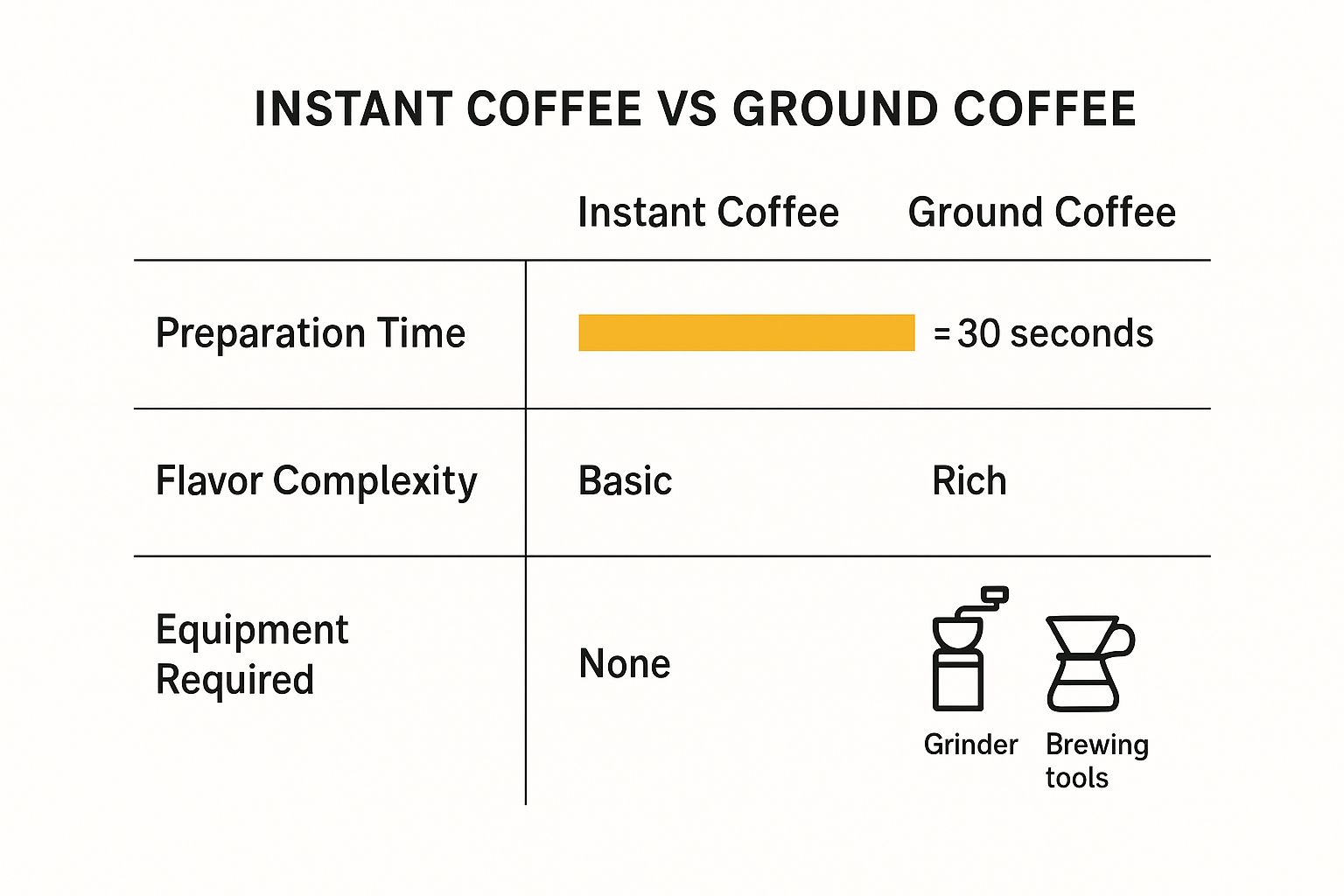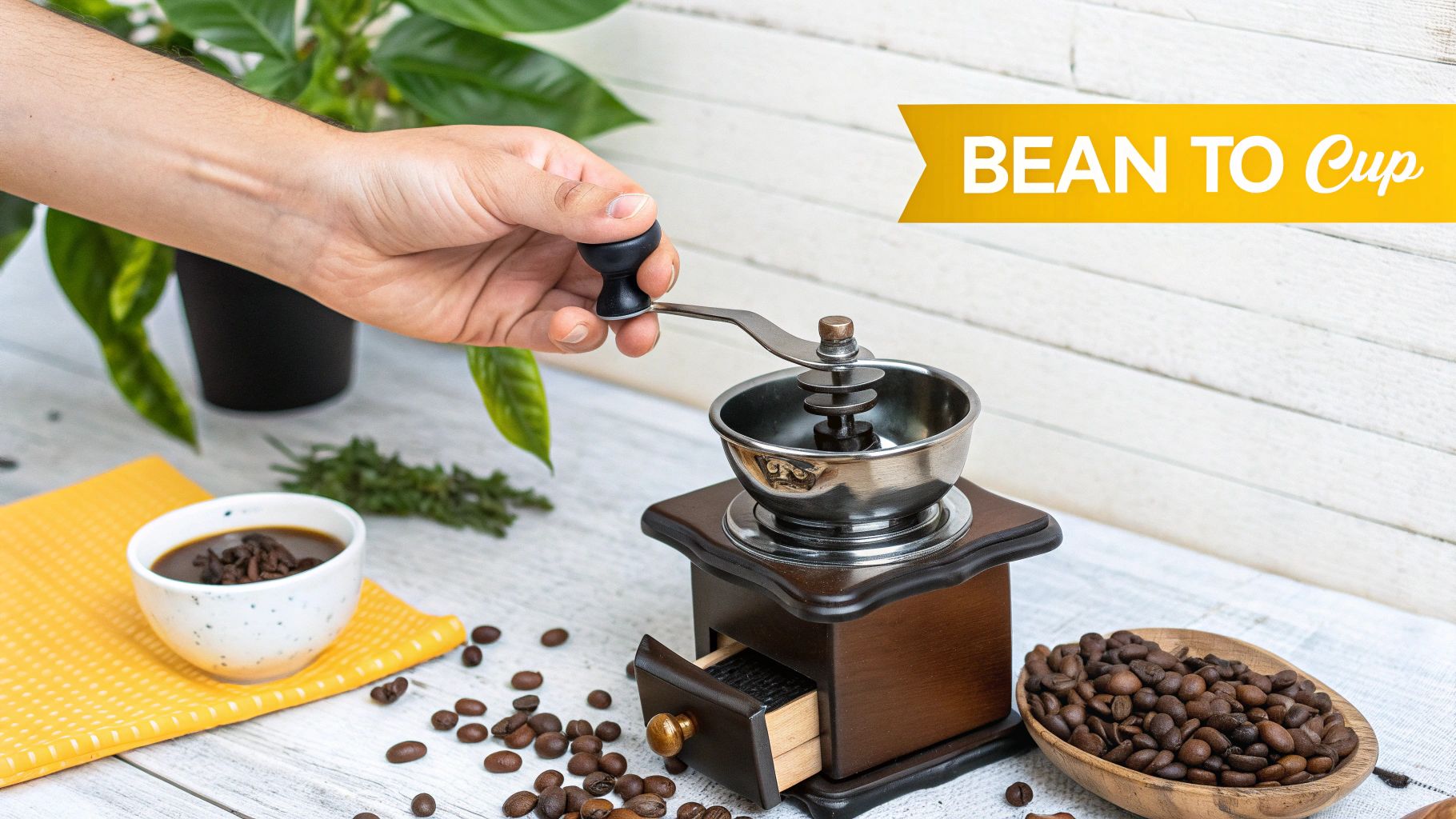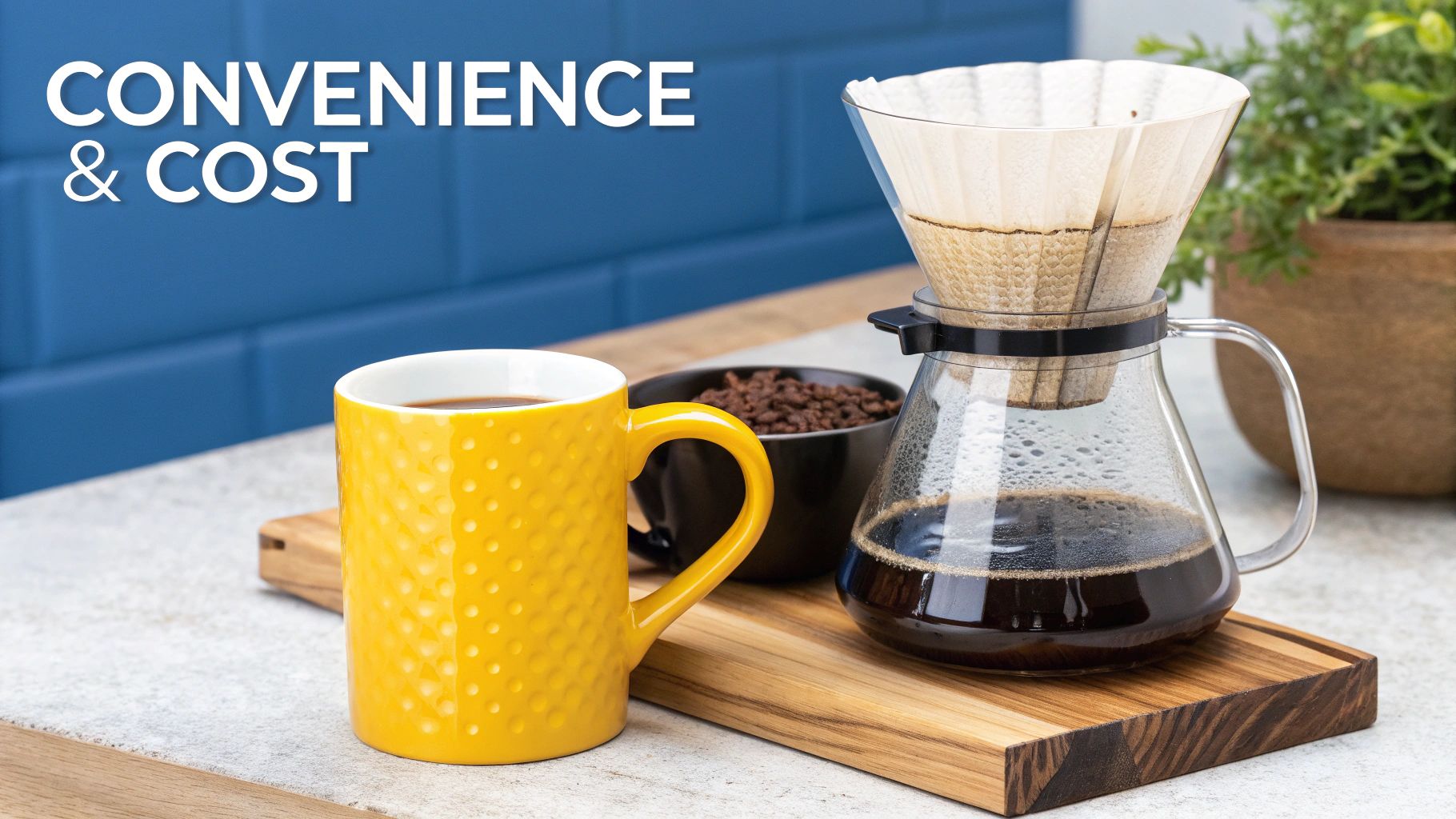When it comes to instant coffee vs ground coffee, the choice really comes down to what you value most in that moment. Instant coffee gives you unbeatable speed and simplicity, while ground coffee is all about a superior flavor experience and the ritual of brewing.
Truth be told, neither is objectively "better." They're just different tools for different situations.
Decoding Your Daily Coffee Choice
The debate isn't about crowning a single winner; it's about figuring out which one fits your life. One is built for pure efficiency—think hectic mornings or travel. The other provides that rich, aromatic experience that so many of us cherish as a daily ritual.
At the end of the day, both start as simple coffee beans but take wildly different journeys to get into your cup.
Ground coffee is exactly what it sounds like: whole roasted coffee beans that have been ground into a powder. To get any flavor out of it, you need a brewing process, whether that's a drip machine, a French press, or a pour-over. This is how you extract all those complex flavors and aromas.
Instant coffee, on the other hand, is coffee that has already been brewed. The liquid coffee is then dehydrated, usually through freeze-drying or spray-drying, leaving behind soluble crystals. Just add hot water, and you've rehydrated it back into a cup of coffee.
Instant vs Ground Coffee Key Differences at a Glance
To make things simple, here's a quick look at the main trade-offs you're making when you pick one over the other.
| Factor | Instant Coffee | Ground Coffee |
|---|---|---|
| Preparation Time | Roughly 30 seconds | Usually 4-5 minutes |
| Flavor Profile | Milder, often more uniform | Complex, nuanced, and aromatic |
| Equipment | Just a mug and hot water | Brewer, filters, maybe a grinder |
| Convenience | Extremely high | Lower; the brewing process takes time |
| Cost Per Cup | Generally lower | Varies widely, but often higher |
This table lays out the core differences, but a visual can often make it even clearer.

As you can see, instant coffee's main selling point is its almost non-existent prep time and minimal equipment. It’s the undisputed champion of convenience.
Understanding these fundamental distinctions is the first real step in deciding which coffee truly fits your daily routine.
How Your Coffee Gets from Bean to Cup

To really get to the bottom of the instant coffee vs ground coffee debate, you have to look at how each one makes its way from a roasted bean into your mug. They both start from the same place—the humble coffee bean—but their paths diverge so much that they end up as two completely different products.
Ground coffee has a pretty direct journey. You take whole, roasted coffee beans and simply grind them down. The whole point of this is to increase the surface area of the coffee, which is what allows the hot water to pull out all that delicious flavor when you brew it.
That’s where the grind size becomes so important. A chunky, coarse grind works best for a French press, while you need a super-fine powder for a great shot of espresso. Once the beans are ground, that’s it. They’re packaged up with all their natural oils and aromatic compounds still inside, just waiting for you to brew them.
The Path of Instant Coffee
Instant coffee, on the other hand, goes through a much more involved process. It actually starts where ground coffee's journey ends: by getting brewed. Huge quantities of coffee are brewed to create a super-concentrated liquid.
The next step is to get rid of all the water, leaving only the coffee solids behind. There are two main ways to do this, and the method used has a huge impact on the final quality and price.
- Spray-Drying: The coffee concentrate is atomized into a fine mist and blasted with hot air. The water evaporates almost instantly, leaving behind the fine powder you see in many standard instant coffees. It's fast and cheap, but can be harsh on the flavor.
- Freeze-Drying: Here, the coffee extract is frozen solid and then placed in a powerful vacuum. The ice turns directly into vapor, a process called sublimation, leaving behind lighter, chunkier coffee crystals. This method is much gentler and does a better job of preserving the coffee's original aroma and taste.
This is why instant coffee dissolves right into water—it's essentially coffee that's been brewed once, dehydrated, and is now being rehydrated. You’re just adding the water back in.
Knowing how they’re made really clears up why instant and ground coffee are such different beasts. The whole "is it real coffee?" debate usually comes down to this complex manufacturing process. If you’re interested in diving deeper, you can explore whether instant coffee is real coffee and see how it truly stacks up. This background is key to understanding what each type of coffee brings to the table.
Comparing Flavor, Aroma, and Overall Quality

When you get right down to it, the real showdown between instant coffee vs ground coffee happens in the cup. This is where the sensory experience—the taste, the smell, and that hard-to-define "quality"—truly sets them apart.
Ground coffee is prized for its complex and lively flavor profile. Think of it as a direct reflection of the bean's journey: its origin, how it was processed, and the specific roast level. It holds onto its natural oils and aromatic compounds right up until you add hot water, delivering a rich, layered experience. This is where you find those nuanced tasting notes, from bright and fruity to deep and chocolatey.
On the other hand, instant coffee has long been known for a more straightforward, often one-dimensional taste. The traditional manufacturing process, especially the intense heat of spray-drying, tends to strip away the delicate flavors and aromas that make coffee so special.
How Processing Shapes the Taste
The path a coffee bean takes fundamentally changes how it tastes. Ground coffee is a pretty simple product—its flavor comes down to the bean's natural quality and the roaster's touch. Freshness is everything here. The closer you brew to the day the beans were ground, the more vibrant and aromatic your coffee will be.
Instant coffee's flavor is a product of its transformation from a liquid brew into a solid crystal and back again. The freeze-drying method, while more costly, is much gentler than spray-drying. It does a far better job of preserving the coffee's original character.
The core difference lies in preserving the volatile oils. Ground coffee hangs onto these oils until the moment of brewing, releasing a fresh, intense aroma. The dehydration process for instant coffee causes many of these delicate compounds to evaporate, which is why it often lacks that same aromatic punch.
This is exactly why coffee lovers have historically stuck with ground beans. But things are starting to shift as premium brands pour resources into making better-tasting soluble coffee.
Is the Quality Gap Closing?
While a freshly brewed cup of ground coffee still holds the title for peak flavor, the world of instant coffee is getting a serious upgrade. A new generation of specialty instant coffee makers is using high-quality Arabica beans and sophisticated freeze-drying methods to create products that are surprisingly complex.
These premium options are smashing old stereotypes, and it's happening alongside massive market growth. The global instant coffee market was valued at around $45 billion in 2022 and is projected to hit $55 billion by 2025, fueled by our need for convenience. You can find more details on soluble coffee market trends on vinanhatrang.com.
Even with these new and improved options, sometimes you need a few tricks up your sleeve. If you're looking to get the most out of your quick cup, check out our guide on how to make instant coffee taste better. The best modern instant coffees are no longer just about speed; they're about delivering a genuinely enjoyable flavor that honors the bean.
The Practical Choice: Convenience, Cost, and Access

While we can talk all day about flavor notes and aromas, for most people, the real decision between instant coffee vs. ground coffee comes down to the practical stuff. Convenience, cost, and accessibility are what really shape our daily coffee habits and determine which one fits into our actual lives.
When it comes to sheer speed, instant coffee wins, no contest. It's the definition of "just add water." You don't need any special gear—just a kettle or microwave and a mug. We're talking about a cup of coffee made in under a minute, which is a lifesaver on chaotic mornings, in a shared office kitchen, or when you're completely off the grid while camping.
Ground coffee, on the other hand, asks you to slow down. It’s a process, a small ritual that requires time and tools, whether that’s a drip coffee maker, a French press, or a pour-over setup. For some, that ritual is a treasured part of the morning. For others, it’s just one more thing to do when they’re already running late.
Breaking Down the Cost Per Cup
At first glance on the grocery store shelf, a bag of ground coffee and a jar of instant might look like they're in the same price range. But the real story is in the cost per cup.
Generally, instant coffee is the more economical choice. You only need a small spoonful of those freeze-dried crystals to make a full cup, meaning a single jar can stretch much further than a bag of ground coffee of a similar size.
Ground coffee's price tag is all over the map. You can find plenty of budget-friendly options, but once you step into the world of specialty single-origin beans, the cost can climb quickly. Don't forget the initial investment in brewing equipment, which adds to the total expense and makes ground coffee a bigger financial commitment from the get-go.
If you're watching your budget or just want to trim down daily spending, instant coffee almost always comes out on top. Those small savings on each cup really start to add up over the weeks and months.
Accessibility in Different Scenarios
Both types of coffee are easy to find at any supermarket, but they really shine in different situations. Think of instant coffee as the ultimate travel buddy—it's lightweight, compact, and doesn't need any support gear. It’s the perfect solution for anyone who needs a caffeine fix without any fuss.
Ground coffee’s accessibility is tied to having the right setup. It's ideal for your home or office, where you have the space and equipment to do it justice. This practical divide is clear in market trends. In the U.S., for instance, the instant coffee market is projected to hit $8.80 billion by 2032, largely because of its unmatched convenience. You can dig deeper into the U.S. coffee market data on researchandmarkets.com.
Ultimately, the choice comes down to what you prioritize: the effortless speed and affordability of instant or the richer, more hands-on experience that comes with brewing ground coffee.
Health and Sustainability: Which Coffee Comes Out on Top?
When you're standing in the coffee aisle, the choice between instant and ground isn't just about taste. Your decision ripples out, affecting both your well-being and the planet. Each one has its own story when it comes to health and environmental impact.
Let's start with health. Both forms of coffee are packed with antioxidants, which is great news for your body. But the way instant coffee is made can slightly change its nutritional makeup.
Ground coffee generally packs a bigger punch when it comes to caffeine. A typical cup of brewed coffee contains anywhere from 70 to 140 mg of caffeine. In contrast, a cup of instant usually lands between 30 and 90 mg, making it a smarter choice if you're sensitive to caffeine's jolt. For a deeper dive, check out our guide on how healthy instant coffee really is.
Unpacking the Environmental Footprint
When we talk sustainability, the winner isn't so clear-cut. The biggest knock against ground coffee is the waste it creates. All those used grounds and paper filters often get tossed in the trash, heading straight to a landfill where they release methane.
On the flip side, instant coffee can have a surprisingly lighter footprint. The production process is quite efficient, and because the final product is so concentrated and lightweight, it takes a lot less energy and packaging to get it from the factory to your kitchen.
One of the biggest wins for instant coffee is resource efficiency. Studies have shown that making a cup of instant coffee uses less water and energy at home than most traditional brewing methods. This is because you only heat the exact amount of water you need.
How Global Trends Shape Your Coffee Cup
These health and environmental considerations are becoming a bigger deal for coffee drinkers everywhere. The global appetite for coffee is huge and still growing, with the market projected to hit $369.46 billion by 2030.
Within that massive industry, both instant and ground coffee have their place. Instant coffee, in particular, is on a major growth trajectory, expected to become a $76.4 billion market by 2035. This boom is driven by people wanting quality and convenience, and it's pushing producers to clean up their act with more sustainable practices. You can see more data on the global instant coffee market on factmr.com.
This growth means we're seeing more innovation across the board—from compostable bags for ground beans to more energy-efficient factories for instant. A truly conscious choice means looking at the coffee's entire journey.
Sustainability Scorecard
| Environmental Factor | Instant Coffee | Ground Coffee |
|---|---|---|
| Transport Emissions | Lower due to light weight | Higher due to bulk |
| Brewing Waste | Minimal (no grounds or filters) | High (used grounds, filters) |
| Water & Energy Use | Generally lower per cup | Higher, varies by brew method |
| Packaging | Often less per serving | More packaging per serving |
So, Which Coffee Should You Choose?
The whole instant versus ground coffee debate isn't really about finding a single winner. It's more about knowing which one to reach for in a given moment. Think of it like having different tools in a toolbox—you wouldn't use a sledgehammer for a finishing nail.
Your coffee choice should fit the situation, whether you're sprinting out the door on a Monday morning or easing into a lazy weekend. Let's walk through a few real-world scenarios to see which brew makes the most sense.
A Coffee for Every Occasion
-
The Morning Rush: If your mornings feel more like a countdown timer, instant coffee is your best friend. Having a decent cup of coffee ready in less than 60 seconds, with practically no cleanup, is a game-changer. You get the caffeine you need without any of the fuss.
-
The Backpacker's Brew: When you're out on the trail, pack weight and space are everything. Instant coffee is incredibly lightweight, takes up almost no room, and all you need is hot water. It’s the simplest way to get a warm, comforting cup while watching the sunrise from your tent.
-
The Weekend Ritual: For those who truly love the experience of coffee, ground coffee is the clear choice. The process of grinding the beans, the aroma that fills the kitchen, and the rich, complex flavors in the final cup are part of a ritual that instant just can't match. This is for the moments you want to slow down and savor.
-
The Student's Staple: When you're on a tight budget, the cost-per-cup really matters. A large jar of instant coffee can stretch for weeks, making it a super affordable way to stay caffeinated through late-night study sessions.
In the end, there's no need to pick a side. The smartest move is to keep both in your pantry. Use your favorite ground coffee for the times you can truly enjoy it, and have instant ready for those days when convenience is king. That way, you’re always set with the right coffee for any moment.
Your Questions, Answered
Even after breaking it all down, you probably have a few more questions rattling around. Let's clear up some of the common uncertainties when it comes to the instant coffee vs ground coffee choice.
Is Premium Instant Coffee as Good as Fresh Ground?
This is the big one, isn't it? Honestly, it all comes down to what you mean by "good." Modern specialty instant coffee is lightyears ahead of what your grandparents drank. Advanced freeze-drying locks in a surprising amount of complexity, delivering a cup that is genuinely enjoyable.
That said, fresh ground coffee still has a slight edge on pure sensory experience. The aromatic punch and the delicate, volatile oils you get right after grinding are tough to replicate. Think of it this way: premium instant gets you 90% of the way there with almost zero effort, but for that final 10% of aromatic bliss, fresh ground coffee remains the champion.
Which Coffee Has a Longer Shelf Life?
Instant coffee wins this one by a landslide. The dehydration process makes it incredibly stable. An unopened jar can sit in your pantry for years and still be perfectly fine. Once you open it, you’ll want to use it within a few months to get the best flavor, but it’s not going to go bad.
Ground coffee, on the other hand, is a race against the clock. Oxygen is its enemy, and as soon as it's ground, the clock starts ticking. For the best, most vibrant taste, you really should aim to use it within one to two weeks of opening the bag.
Pro Tip: To keep either coffee at its best, store it in an airtight container in a cool, dark place. The pantry is perfect. Resist the urge to put it in the freezer—the condensation can do more harm than good to the flavor.
Can You Use Instant Coffee in Recipes?
Absolutely! In fact, instant coffee is a secret weapon for many bakers and cooks. Its granules dissolve effortlessly into batters, sauces, and frostings without adding unwanted liquid, which can mess with the chemistry of a recipe.
It’s the perfect way to get a concentrated kick of coffee flavor into things like:
- Rich chocolate brownies and cakes
- Classic tiramisu
- Savory marinades and dry rubs for meat
Using instant coffee gives you all the flavor without the fuss of brewing a pot and reducing it down. It's a simple, brilliant shortcut.
Ready to experience the convenience of high-quality, organic instant coffee? Cartograph Coffee offers a rich, flavorful cup that's ready in seconds. Taste the difference for yourself at https://cartographcoffee.com.